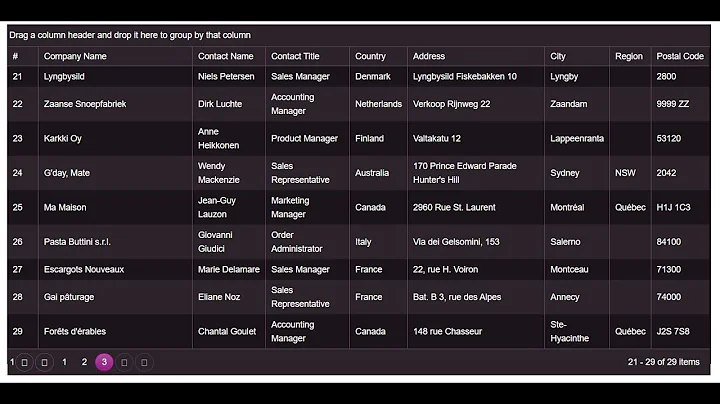Make cell readonly in Kendo Grid if condition is met
Solution 1
Notes:
- this solution works for in-cell editing only (inline or popup editing require a different approach)
- the first approach can lead to unwanted visual effects (grid jumping) under certain circumstances; if you experience that, I recommend approach #2
- approach #2 may not work if you want to use the MVC wrappers (although it may be possible to extend Kendo.Mvc.UI.Fluent.GridEventBuilder); in that case, you'll need to bind the edit handler in JS
Approach #1
Use the grid's edit event and then do something like this:
$("#grid").kendoGrid({
dataSource: dataSource,
height: "300px",
columns: columns,
editable: true,
edit: function (e) {
var fieldName = e.container.find("input").attr("name");
// alternative (if you don't have the name attribute in your editable):
// var columnIndex = this.cellIndex(e.container);
// var fieldName = this.thead.find("th").eq(columnIndex).data("field");
if (!isEditable(fieldName, e.model)) {
this.closeCell(); // prevent editing
}
}
});
/**
* @returns {boolean} True if the column with the given field name is editable
*/
function isEditable(fieldName, model) {
if (fieldName === "SomeForeignKeyID") {
// condition for the field "SomeForeignKeyID"
// (default to true if defining property doesn't exist)
return model.hasOwnProperty("IsFkEnabled") && model.IsFkEnabled;
}
// additional checks, e.g. to only allow editing unsaved rows:
// if (!model.isNew()) { return false; }
return true; // default to editable
}
Demo here (updated for Q1 2014)
To use this via the MVC fluent syntax, simply give the anonymous edit function above a name (e.g. onEdit):
function onEdit(e) {
var fieldName = e.container.find("input").attr("name");
// alternative (if you don't have the name attribute in your editable):
// var columnIndex = this.cellIndex(e.container);
// var fieldName = this.thead.find("th").eq(columnIndex).data("field");
if (!isEditable(fieldName, e.model)) {
this.closeCell(); // prevent editing
}
}
and reference it like this:
@(Html.Kendo().Grid()
.Name("Grid")
.Events(events => events.Edit("onEdit"))
)
The disadvantage to this is that the editor gets created first before the edit event is triggered, which can sometimes have undesirable visual effects.
Approach #2
Extend the grid by overriding its editCell method with a variation that triggers a beforeEdit event; for that to work with grid options, you'll also need to override the init method:
var oEditCell = kendo.ui.Grid.fn.editCell;
var oInit = kendo.ui.Grid.fn.init;
kendo.ui.Grid = kendo.ui.Grid.extend({
init: function () {
oInit.apply(this, arguments);
if (typeof this.options.beforeEdit === "function") {
this.bind("beforeEdit", this.options.beforeEdit.bind(this));
}
},
editCell: function (cell) {
var that = this,
cell = $(cell),
column = that.columns[that.cellIndex(cell)],
model = that._modelForContainer(cell),
event = {
container: cell,
model: model,
field: column.field
};
if (model && this.trigger("beforeEdit", event)) {
// don't edit if prevented in beforeEdit
if (event.isDefaultPrevented()) return;
}
oEditCell.call(this, cell);
}
});
kendo.ui.plugin(kendo.ui.Grid);
then use it similar to #1:
$("#grid").kendoGrid({
dataSource: dataSource,
height: "300px",
columns: columns,
editable: true,
beforeEdit: function(e) {
var columnIndex = this.cellIndex(e.container);
var fieldName = this.thead.find("th").eq(columnIndex).data("field");
if (!isEditable(fieldName, e.model)) {
e.preventDefault();
}
}
});
The difference of this approach is that the editor won't get created (and focused) first. The beforeEdit method is using the same isEditable method from #1.
See a demo for this approach here.
If you want to use this approach with MVC wrappers but don't want / can't extend GridEventBuilder, you can still bind your event handler in JavaScript (place below the grid MVC initializer):
$(function() {
var grid = $("#grid").data("kendoGrid");
grid.bind("beforeEdit", onEdit.bind(grid));
});
Solution 2
None of these approaches worked for me. A very simple implentation looks like this
edit: function (e) {
e.container.find("input[name='Name']").each(function () { $(this).attr("disabled", "disabled") });
}
Where edit is part of the kendo grid declaration and Name is the actual name of the field.
Solution 3
Please try with the below code snippet.
VIEW
<script type="text/javascript">
function errorHandler(e) {
if (e.errors) {
var message = "Errors:\n";
$.each(e.errors, function (key, value) {
if ('errors' in value) {
$.each(value.errors, function () {
message += this + "\n";
});
}
});
alert(message);
}
}
function onGridEdit(arg) {
if (arg.container.find("input[name=IsFkEnabled]").length > 0) {
arg.container.find("input[name=IsFkEnabled]").click(function () {
if ($(this).is(":checked") == false) {
}
else {
arg.model.IsFkEnabled = true;
$("#Grid").data("kendoGrid").closeCell(arg.container);
$("#Grid").data("kendoGrid").editCell(arg.container.next());
}
});
}
if (arg.container.find("input[name=FID]").length > 0) {
if (arg.model.IsFkEnabled == false) {
$("#Grid").data("kendoGrid").closeCell(arg.container)
}
}
}
</script>
<div>
@(Html.Kendo().Grid<MvcApplication1.Models.TestModels>()
.Name("Grid")
.Columns(columns =>
{
columns.Bound(p => p.ID);
columns.Bound(p => p.Name);
columns.Bound(p => p.IsFkEnabled);
columns.ForeignKey(p => p.FID, (System.Collections.IEnumerable)ViewData["TestList"], "Value", "Text");
})
.ToolBar(toolBar => toolBar.Save())
.Editable(editable => editable.Mode(GridEditMode.InCell))
.Pageable()
.Sortable()
.Scrollable()
.Filterable()
.Events(e => e.Edit("onGridEdit"))
.DataSource(dataSource => dataSource
.Ajax()
.Batch(true)
.ServerOperation(false)
.Events(events => events.Error("errorHandler"))
.Model(model =>
{
model.Id(p => p.ID);
model.Field(p => p.ID).Editable(false);
})
.Read(read => read.Action("ForeignKeyColumn_Read", "Home"))
.Update(update => update.Action("ForeignKeyColumn_Update", "Home"))
)
)
</div>
MODEL
namespace MvcApplication1.Models
{
public class TestModels
{
public int ID { get; set; }
public string Name { get; set; }
public bool IsFkEnabled { get; set; }
public int FID { get; set; }
}
}
CONTROLLER
public class HomeController : Controller
{
public ActionResult Index()
{
List<SelectListItem> items = new List<SelectListItem>();
for (int i = 1; i < 6; i++)
{
SelectListItem item = new SelectListItem();
item.Text = "text" + i.ToString();
item.Value = i.ToString();
items.Add(item);
}
ViewData["TestList"] = items;
return View();
}
public ActionResult ForeignKeyColumn_Read([DataSourceRequest] DataSourceRequest request)
{
List<TestModels> models = new List<TestModels>();
for (int i = 1; i < 6; i++)
{
TestModels model = new TestModels();
model.ID = i;
model.Name = "Name" + i;
if (i % 2 == 0)
{
model.IsFkEnabled = true;
}
model.FID = i;
models.Add(model);
}
return Json(models.ToDataSourceResult(request));
}
[AcceptVerbs(HttpVerbs.Post)]
public ActionResult ForeignKeyColumn_Update([DataSourceRequest] DataSourceRequest request, [Bind(Prefix = "models")]IEnumerable<TestModels> tests)
{
if (tests != null && ModelState.IsValid)
{
// Save/Update logic comes here
}
return Json(ModelState.ToDataSourceResult());
}
}
If you want to download demo then click here.
Solution 4
The simplest way is to use the dataBound event to conditionally apply one of the special CSS classes to the cells that the grid ignore for editing:
-
dataBound: function(e) { var colIndex = 1; var rows = this.table.find("tr:not(.k-grouping-row)"); for (var i = 0; i < rows.length; i++) { var row = rows[i]; var model = this.dataItem(row); if (!model.Discontinued) { var cell = $($(row).find("td")[colIndex]); cell.addClass("k-group-cell"); } } },
Related videos on Youtube
Andrzej
Updated on September 15, 2021Comments
-
Andrzej almost 3 years
Let's say I have a data like this:
[ {ID: 1, SomeForeignKeyID: 4, IsFkEnabled: true}, {ID: 2, SomeForeignKeyID: 9, IsFkEnabled: false} ]Kendo Grid is using this data:
columns.Bound(m => m.ID); columns.ForeignKey(p => p.SomeForeignKeyID, ViewBag.ForeignKeys as IEnumerable<object>, "Value", "Name");Here's the problem: how to make ForeignKey column editable, but only in rows, where IsFkEnabled == true? Edit mode is InCell.
-
OnaBai over 10 yearsThis is not supported by Kendo UI out-of-the-box but you can implement it but a clean/easy implementation is dependent on the type of edition that you are using. Is it inline, popup or incell?
-
-
JDC almost 10 yearsTelerik, please implement approach 2 out of the box!
-
Zzz over 9 yearsI was wondering if anyone has an example of how to implement this fo inline editing?
-
 Lars Höppner over 9 years@Azzi one option here: stackoverflow.com/questions/24722893/…
Lars Höppner over 9 years@Azzi one option here: stackoverflow.com/questions/24722893/… -
HenrikJohnson over 9 yearsI had problems hooking up the event (I am creating the grid using MVC bindings). In the end I just implemented my entire event handler in the editCell implementation. Should be OK for my case since I only have on grid on the page.
-
 Lars Höppner over 9 yearsright, for the MVC fluent builders, you'd probably need to extend Kendo.Mvc.UI.Fluent.GridEventBuilder if you want to use beforeEdit; I should have mentioned that
Lars Höppner over 9 yearsright, for the MVC fluent builders, you'd probably need to extend Kendo.Mvc.UI.Fluent.GridEventBuilder if you want to use beforeEdit; I should have mentioned that -
 Lars Höppner over 9 years@HenrikJohnson I added a paragraph at the end - if you have time to try this, I'd be interested if it works for you
Lars Höppner over 9 years@HenrikJohnson I added a paragraph at the end - if you have time to try this, I'd be interested if it works for you -
 Gen1-1 over 4 yearsIf you are using a version before 2017 R2 which added an official BeforeEdit event, and you are using the MVC wrappers ("Kendo MVC"), this hack is a neat way to solve it. If you use it, I recommend adding a comment in your code as to why you are hi-jacking the k-group-cell class, so that those who read your code in the future understand.
Gen1-1 over 4 yearsIf you are using a version before 2017 R2 which added an official BeforeEdit event, and you are using the MVC wrappers ("Kendo MVC"), this hack is a neat way to solve it. If you use it, I recommend adding a comment in your code as to why you are hi-jacking the k-group-cell class, so that those who read your code in the future understand.








